-
Posts
2,106 -
Joined
-
Last visited
Content Type
Profiles
Forums
Articles
Gallery
Downloads
Events
Posts posted by FieryFurnace
-
-
The double collars would look nice, but would require a more squared off design. Sounds like a good modification to this design. Instead of the arches, offer a table that is more square. This would give me another design, and increase my chances of catching someone's eye at a show!
Collaring with the legs on the diamond is also a very good idea, as it would eliminate the other decorative elements that make up the center, and would allow me to offer a still nice table at a little bit cheaper price. Again, increasing my chances of picking up a buyer.
I don't have a whole lot of clients that are strict traditionalists. So that's not an issue. However, I do like traditional methods or at least the appearance of traditional methods, as it looks better than modern methods.....most of the time.
I'm wanting to make about a half dozen tables for this spring's craft show market. Maybe instead of 6 exactly the same, I'll do two rounded ones, two with the simple center, and two with the squared up double collar design. Sounds like it'd keep things more interesting anyway! :D
-
Actually, I was refering to this first question "It looks great, but tell the truth, is there a mig weld under the coller?"
As for this, you're correct, I did. Why weld if it isn't neccessary? Just extra work.
Would you attempt this joint without any holding aid for the pieces, if you had to make this design? If not, what method would you have used to hold the pieces in place?
Always feel free to ask questions on my threads man! :D
-
Do you think it would help to dissipate heat if you drilled holes in the lip of the table where the 1" tubing supports meet the lip on the outside? To let heat escape from inside the 1" tubing?
Im getting my steel tomorrow and am going to build a really similar table.
I doubt it would make a noticeable difference really. Plus, you wouldn't want additional heat getting to your slide-out support rack, if you choose to nest one inside of your pipe supports.
I just got all the pics for the air gate/clinker breaker tutorial, so I hope to get that up soon. No promises, as I'm very busy!
-
No I don't.
I went back and reread the hammer Challange, I think you read far into my post than was my intention.
LOL very well! Like I said, that sort of thing don't bother me. It is all too easy to mistake or misread someone's tone, intention, meaning, point, figure of speech, and any number of things, via forums, emails, chats, etc. That's part of the reason I don't let stuff bother me.
Again, I always enjoy your posts, and hope you'll pardon me for misreading.
Great thoughts John and thanks for sharing. I don't see how this joint could have been made without some sort of holding aid. There is simply too much to line up. You are correct, there are 9 pieces. Of course leg positioning is critical here. The arch in the leg is a true circle so it will "nest" anywhere along the arch. I had to find the center of each leg and line them up very carefully, around the center element. Then the corner pieces had to be centered.
The light duty rivet pins is a good idea and one I've used in tricky forge welding in the past. I think that would be the only option here as wires or clamps would get in the way.
This has been a very interesting conversation! :D G'day to all!
-
Lastly, on the subject of collars: Perhaps I'm alone in this, but I never weld under a collar. A collar is a form of joinery, if done properly, it requires no other help. Nor do I ever hide a weld. If I weld, why would I need to hide it?
You really think just a collar would have been strong enough to hold the legs and filler elements by itself? I don't have a whole lot of experience as regards collaring so I haven't really strength tested them.
As far as what threads that I thought you had an "extremely critical angle" in, I know the one was your thread on the "Mark Aspery Hammer Challenge. I believe you sort of questioned my honesty a bit. :D There was a second one, but I don't even recall what it was to be honest. Like I said, that sort of thing doesn't bother me.
If you did intentional question my honesty, I know I was being honest so why should it bother me?
If I simply misunderstood your post, that's my fault, why should that bother me? :D
Don't worry about it!
-
I believe the welds under the collar was/is necessary on a piece like this. The only sin is (and a very small one at that) is being able to see it. I always weld under collars when it is structurally the smart way to go and it saves a huge amount of time. I do my best to keep the welds from view but I have sinned as well........
Same thing here. I always try to hide the welds. You can see a tiny, tiny bit of the weld on this one, but it takes some definate looking. I'll take a bit more care next time. :D
-
wondering why you would ask that?
I get the idea that Mr. Gerald likes to closely critique techniques.
I'm not sure that a collar here would be strong enough be itself. If all the strain was on it, it would come loose over time. Traditionally I think the route to go would have been flush-rivets either under or on top of the collar running through the legs and central element. The only thing held in by the collar would be the small tapered pieces on the corners.
Every post Mr. Gerald has ever written on my threads has come from an extremely critical angle (whether intentionally or not.) I LIKE THAT! It challenges me to rethink why I chose the methods I did. It shows me to think about the why and not just the how.
That's not to say that next time I'll be riveting instead of welding. I did not take Mr Gerald's post as condescending, and I'm not one to be swayed by other people's opinions alone. There's strength in a multitude of counselors and that's why I ask for other people's input.
I'll still be welding on the others I do. However, I appreciate someone calling me out there, and saying, OK tell us what you did here. It makes me think about why I've chosen the methods I've chosen.
Thanks Mr. Gerald!
-
I would like to be able to offer this theme in coffee, end, night, and dining tables. However, as MacBruce pointed out, the table will undoubtedly get shaky the wider the diameter. This would be increased if, instead of a true circle, the curvature of the legs was oval. I'm thinking possibly stick with the same leg design, keep the curve a true circle. Then just use a taller leg for various purposes. When a larger diameter is need, instead of the central bundle (which would go unseen in a large diameter table anyway,) use a strong flat-bar oval, rectangle, or circle to connect the legs. The legs would not touch but would be placed on the outside edges of the table and would all be attached via the steel band around the top and a steel band in the center inside instead of a collar on the center outside.
Ok maybe that made no sense whatsoever. I'll just post pics when I have to build a bigger one!
There are some tiny air gaps between the wood and steel band, so it can grow without restriction.
-
Your talent always amazes me. Very nice. How many hours do you have in it, if you don't mind sharing?
I never mind sharing hours.......but I didn't keep really good track here. Maybe 12-16 hours. I wasn't concerned about time because this was for an art jury, not just for an art/craft show.
If/when I start producing these for art/craft shows, I will axe the copper nails and go with "forged looking" lags from blacksmith depot. I will make two jigs, one for the ring, and one for the half circle on the legs. I would then set up and do a half dozen or so at a time. I think with that I should be able to get the time down to 8 hours per table.
-
It looks great, but tell the truth, is there a mig weld under the coller?
:D
Yes there! I tack-welded all of the pieces together beneath the collar with 1/2-inch tacks. Then collared. I'd like to think that the strength is in the collar and the tacks were added for the convenience of holding everything together for collaring. :D
-
Primary material 5/8-inch square bar.
Primary technique was the Habermann square corner bend
Also features central collar and steel rivets
Hand-forged copper nails
Locally milled and dried, walnut top
16-inch diameter top
Approximately 22 inches tall!
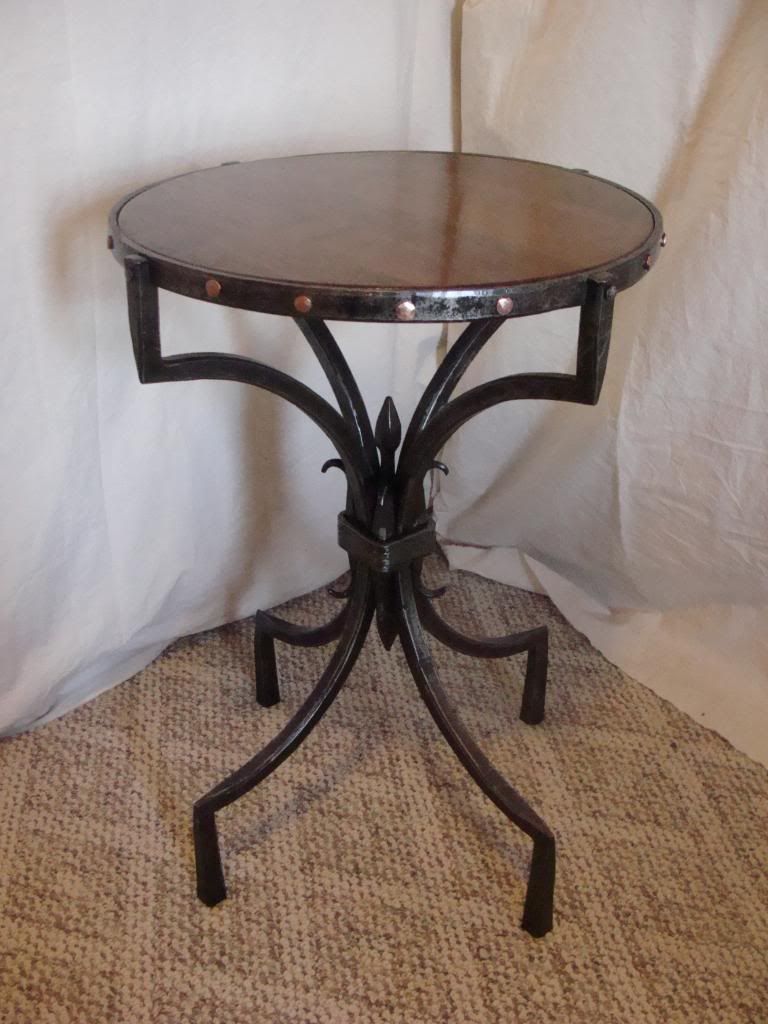
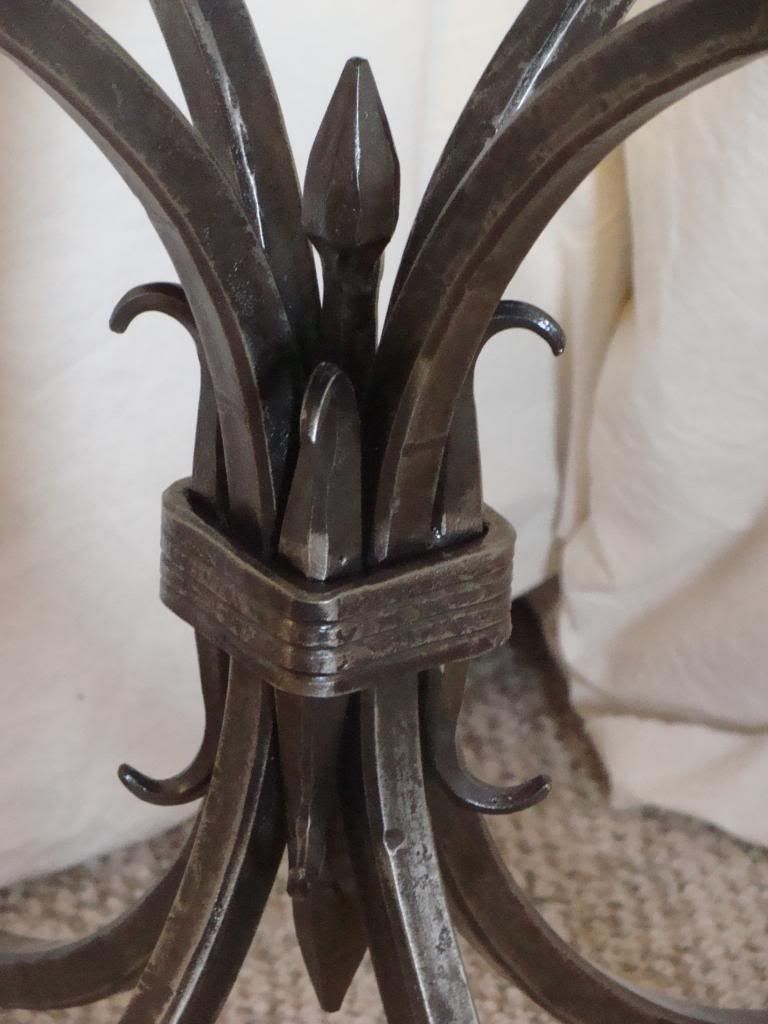

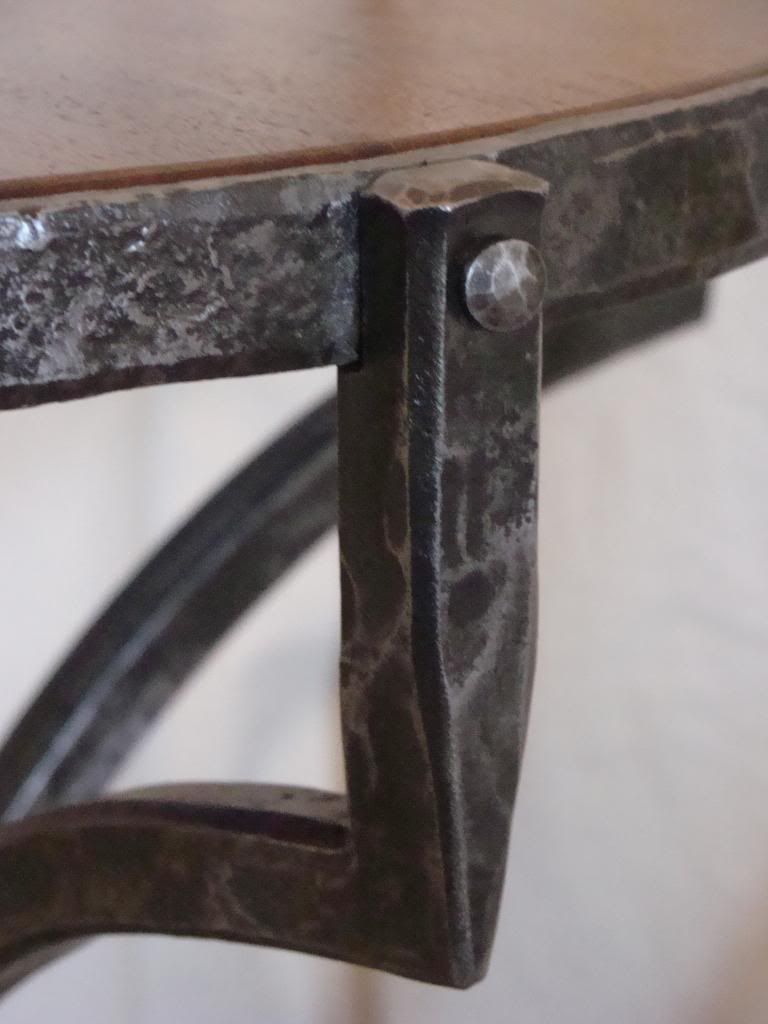
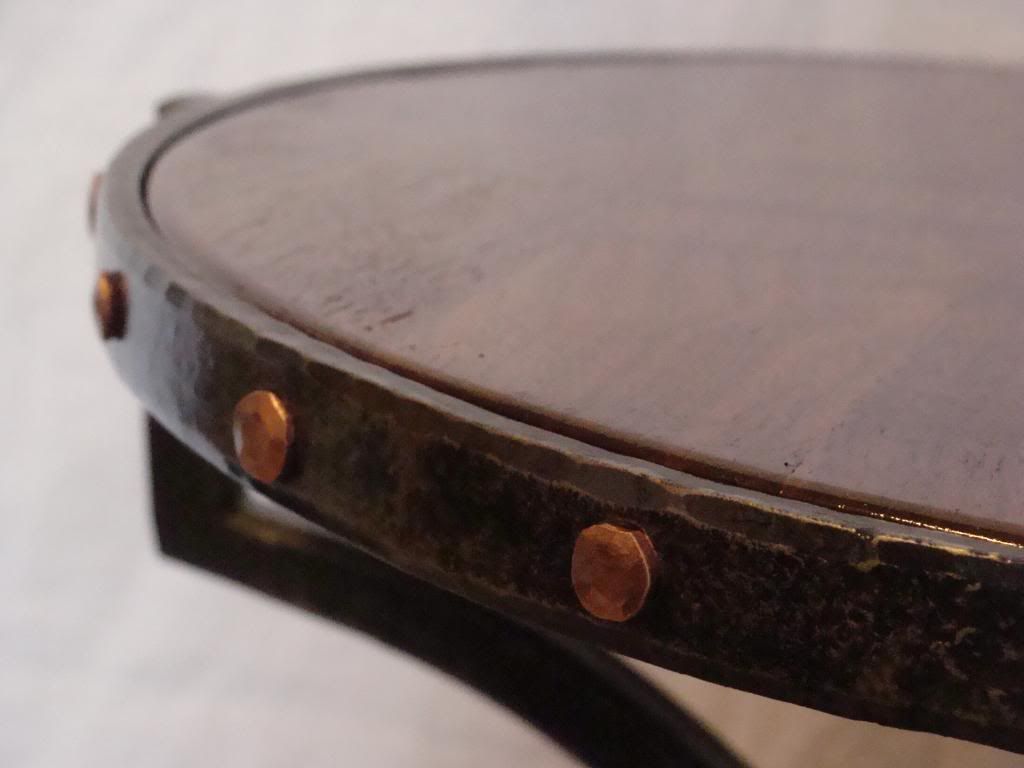
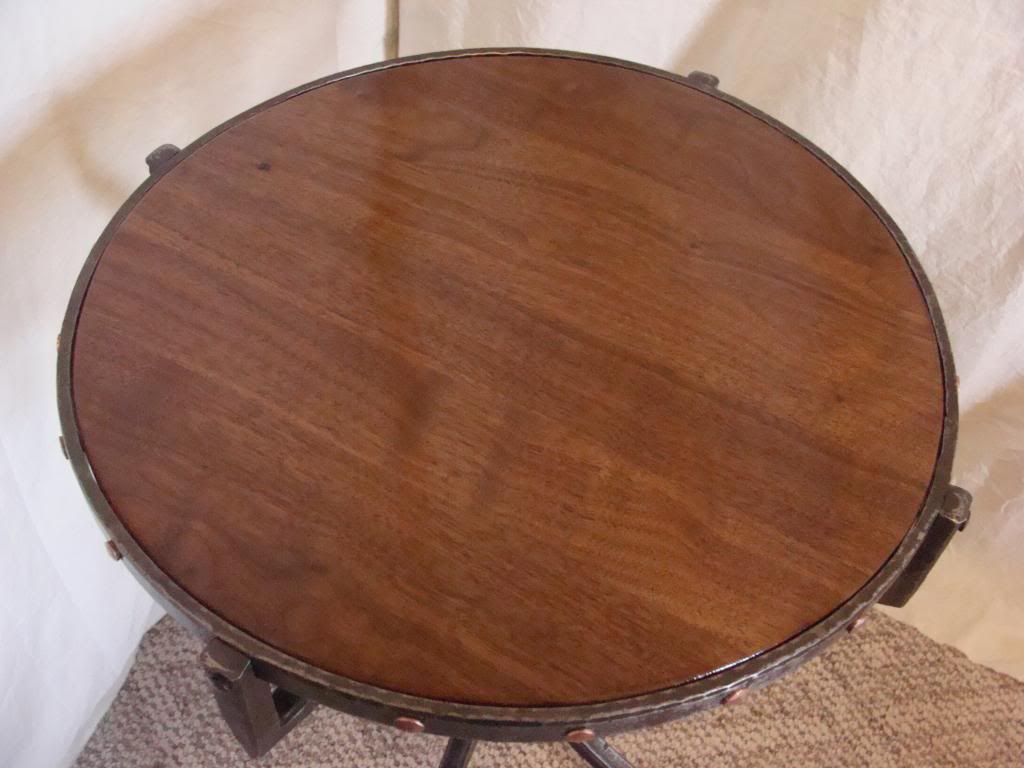
Thoughts?
-
Do you have or could you throw something together quick, to show how that gate, breaker, etc all work? I've been wracking my brain for awhile and I can't come up with any good way to keep that breaker centered and still attached to the handle.
It may take me a couple of days. I'll put it in a new thread, in this section of the forum, entitled something like "fabricated clinker breaker, ash dump, and air gate."
-
I am also interested. I sent the Maynards an e-mail to add me to their list.
PM me your email! I'm still thinking about hosting an event out of my shop, if you are interested!
-
The solid breakers are nice. I used a small triangular one in my last forge. Triangle or square works fine. You need about 1/4-inch gap all the way around it for air flow.
Pugman! Email me when you get some time and want to come.
-
Well, I am convinced now that Carbon Steels are the way to go. Someone mentioned using leaf spring. All I have is leaf spring that is 1/4 thick or thereabouts: how would I make usable tools with it?
Dave, do you use 1/2" coil spring for just punches and drifts, or do you use it for other tools as well? I am going to be making top and bottom fullers and swedges, really. I am going to be using a hand hammer for the time being. Nevertheless, I want my tools to last well after I am gone. (or as long as humanly possible!)
Use car axles for swages and fullers....the handled ones that is.
Hand held tools are easily made from coil spring in sizes from 1/2-inch to 3/4-inch. It's also great material for tongs as well.
-
My (Lewis Meyer) bad there. I did not get out the emails to everyone on my list. I'll try and do better on the next one and post here as well.
Great! Let me know when and where the meetings are. I am interested, you should already have my email and if not PM me. It's a bit of a drive for me I know, but I would really like to attend. I've got some locals here that want to get together but don't want to drive so far as well. I'd love to host a meeting in my shop sometime too. Just get in touch with me via email.
BTW I know Scott and Laura Kellersberger! They are really great people!
-
I would add that a lot of that depends on what it's going to be used for. If you are making a top or bottom fuller that's going to be used with a hand-hammer, then you might get by with it. However, if you are making tooling for heavy forging and sledge or power hammer work, you should not go with mild.
I make mild steel drifts and jigs, but that's about it. I'd make my drifts out of carbon if I had enough sizes of the stuff.
You'll simply spend less time grinding or reforging the faces.
Try you local salvage yard for car axles and heavy springs. 1/2-inch and bigger coil spring and axles are great material. I had to bug my salvage man to death before he started collected coils and axles, but now, I can go up there any time and pick up a dozen each. $5 for axles and $10 for coils. I can get a good 5 or 6 bottom tools from a single axles. It's something like 4140 and holds up really nice without tempering.
-
Yeah I'm not sure if my hammer could withdraw the punch. I wonder how you would tell without making all of the tooling and then blam, FAIL!
I do want to sell my air hammer and build a new air hammer that's larger.....maybe 100-150 pounds. (Depending on what my compressor could run.) But that's another topic for another time.
I don't see a punch press anywhere in my future budget. I suppose I could build a hydraulic press, but they are a bit slow. It'd take a honking press to punch 2-inch + material as well.
One of these days I think it'd be awesome to get two GOOD strikers and two GOOD directors together and forge a couple 12-pound sledge hammers in the Brian Brazeal hand-hammer style.
Metals calculator says a 3-inch solid 4140 billet 6.375-inches long would do the trick. I figure it would take one person holding the billet, one holding the tools, and two striking. Plus an entire spectrum of customized tools. It would be AWESOME though!
-
Building forges ughh! I've built a half dozen or so in my 7 years of smithing. All of them needed tweaking. You learn every-time. There are some minor things that I don't like about my newest forge, but it is WAY more AWESOME than my last on, because I eliminated everything that I disliked about that one.
The thing with masonry forges is they look awesome. That's the up side.
The down sides are as follows.
You can't move them
You can't really alter them much
They are bulky
You can't sell it unless you sell the whole shop
They require a gigantic hole in the roof
They are a pain to disassemble and a other than learning the hard way, are a total loss monetarily.
The bads out-way the goods. The only way I'd ever build a masonry forge is if I'd designed a steel forge that I loved EVERYTHING about.
Having used your forge and seen it in person, I would advocate a total rebuild, but this time in steel! If you make one and don't like it because of this or that, sell it, and rebuild.
-
Ok Yeah! That's what I'd need! A hydrolic press would be the nice way to do it.....in the absence of a punch press that is!
-
Awww you found me out! Durn! I was trying to keep that a secret!
LOL
No girlfriend, no wife, no kids.....and definately no grandkids! LOL Anyway, I'm of the pursuasion that they will only touch it once! :D
-
What gauge metal is the hearth? Also what gauge is the firepot?
Im thinking of building something real similar but am unsure of the thickness I really need?
Would 3/16" be good for both the hearth and the firepot or does the firepot need to be heavier like 1/4"?
Thanks,
Brian
My old fire pot was 3/8-inch plate. I used it for two years and although it shows use, it's got a long life still left. 1/2-inch or 5/8-inch is better. Mine here is 5/8-inch.
The forge plate is 1/8-inch sheet metal. This works fine but the area around the fire pot needs to be supported by 1/4-inch x 1-inch x 1-inch angle or larger, because the heat from the fire pot will warp the sheet metal if it is not supported.
Swing on by sometime Pugman! Will fire-er-up!
-
Stripper plate? Please define! I'm not familiar with that.
I've got the new handle finished and the faces polished up. Thanks for bringing up these suggestions....it's really improved the hammer. Black walnut handle with white oak wedges!
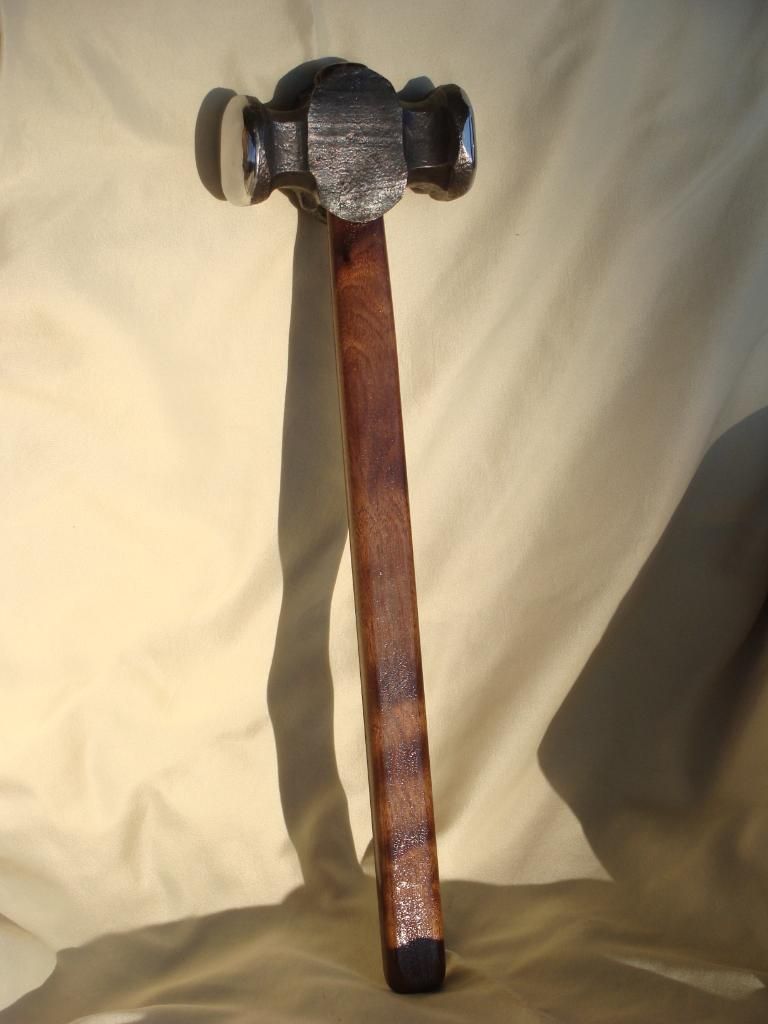

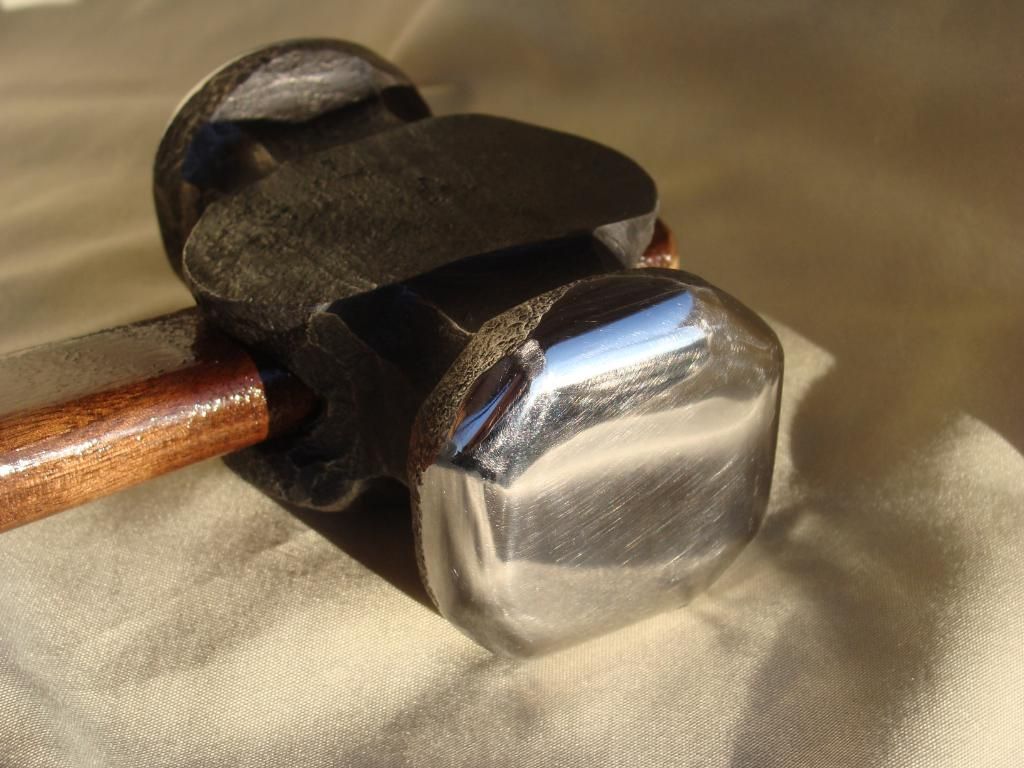
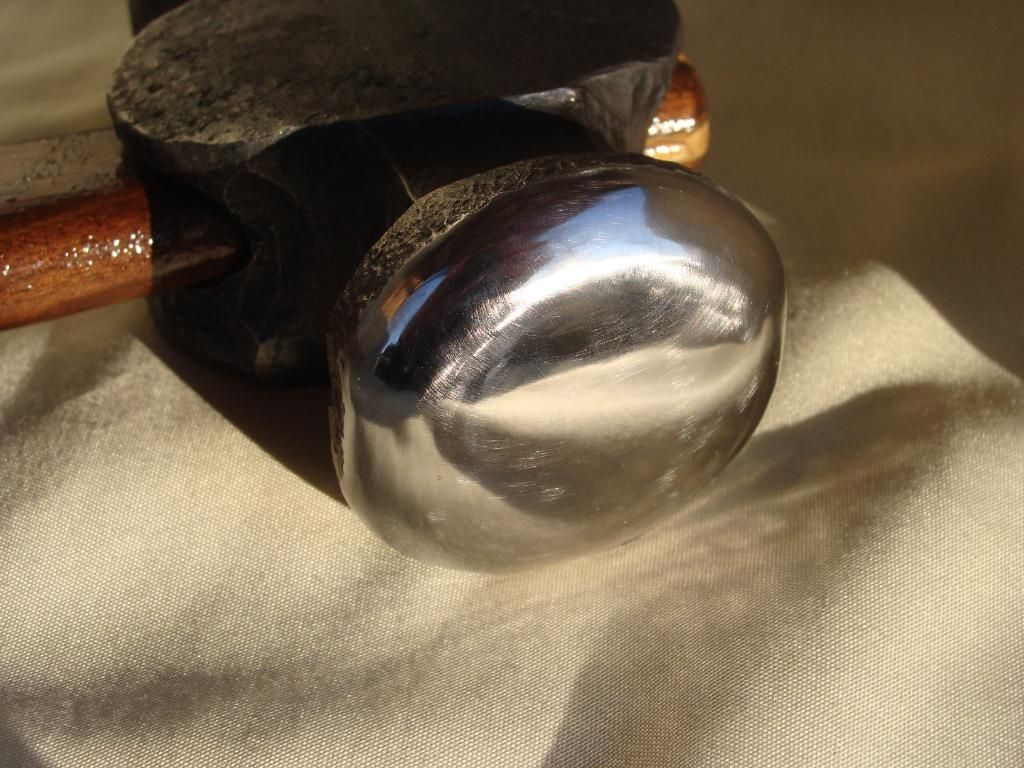
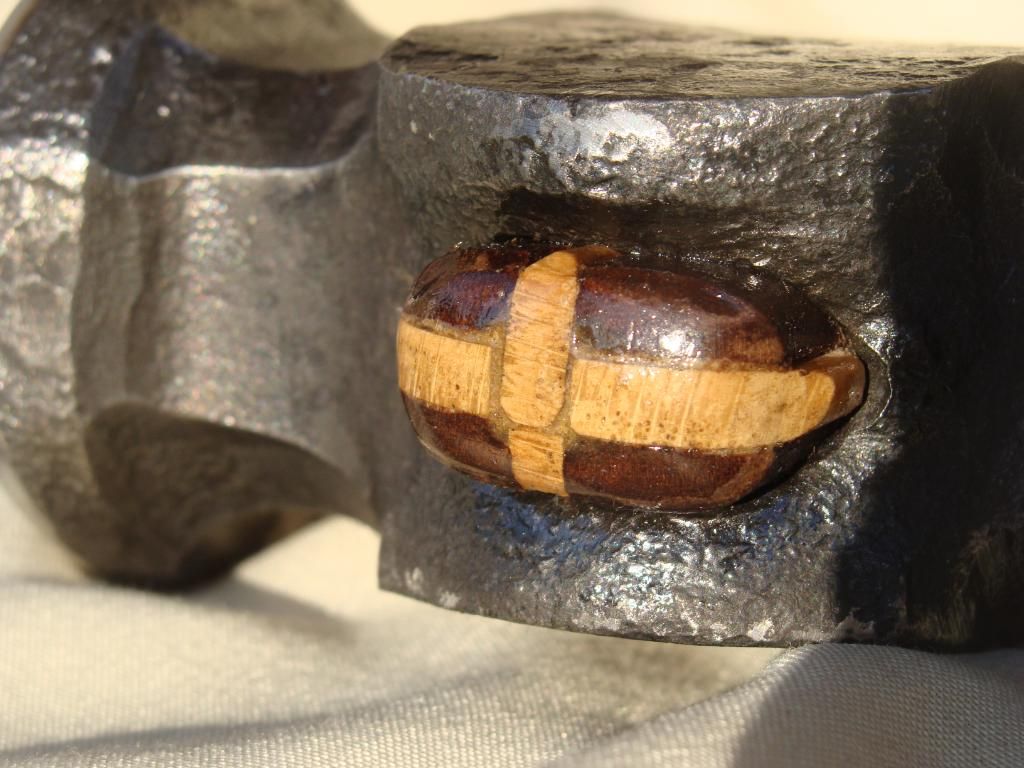

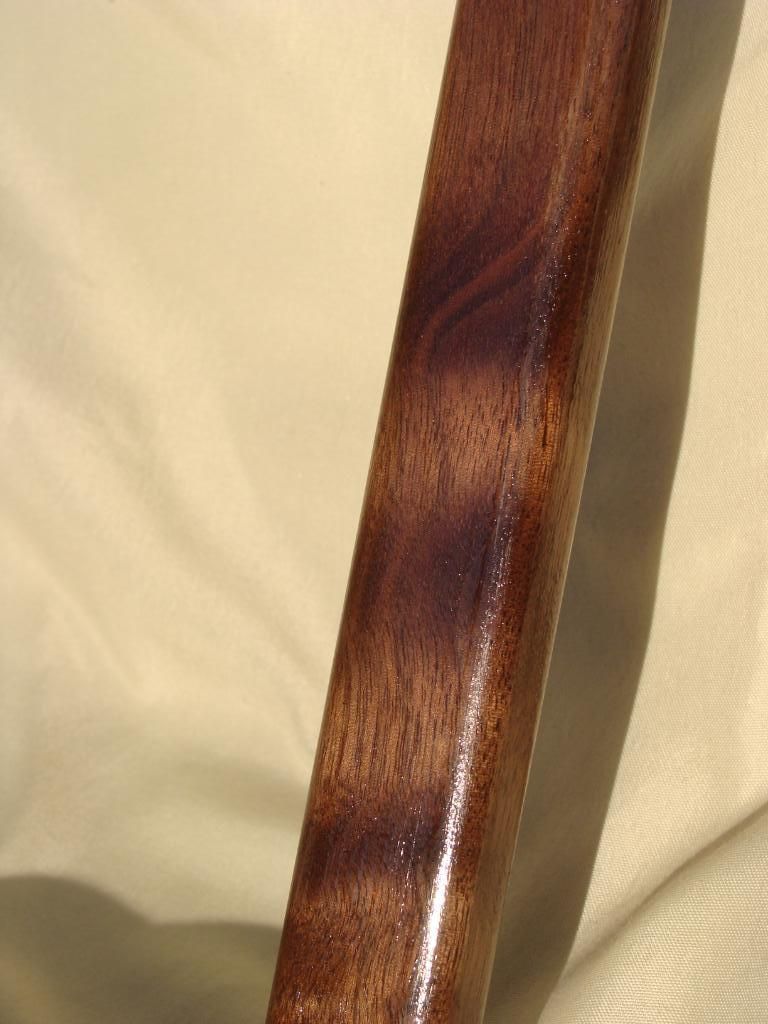
-
I forged for quite a long time with a 2.5-pound cross-peen that cost me a similar amount. round the edges on the face starting with a 60 grit sand paper, then 80, then 100, then 220. 220 grit paper will not give you a mirror polish, but you don't need that. 80 grit would actually probably be all you really have to have.
Just round the edges. Those sharp little grind lines (called facets) are not good for forging. Round everything off. (If you've got a corded screw gun with a disk sander attachment, that works great. Just finished one of my hammers like that the other day.
Switch out to the hickory handle! I believe natural materials are much better and comfortable. Also, I find that a rectangular handle with the corners rounded is the most comfy. The little wavy action that the store-bought handles have are not comfortable, plus those handles are too big around. A simple horse-shoe rasp is all you need to square the handle up.


Shop notes for the end / night table
in Member Projects
Posted
Here are the shop notes for the four legged end table I just finished making. Anyone is welcome to try to make it, just don't tell everyone that it's your design or something. If you have questions I will be happy to help.
The Four Legged End Table 008
General overview
The table width is aproximately 16-inches
The height was originally 24-inches, but the leg length in the notes below yielded a slightly shorter table.
The top is 2-inch walnut strips glued together in a 20-inch square. It was sanded to 220 grit and then coated in Spar-Urethane. It is .75-inch thick.
All measurements are done in decimals so that the numbers automatically get changed over for folks on the metric system. The more difficult decimals have their fractional English equivalents listed as well.
These notes are not a step-by-step instructional on how to make the table. It is simply general information about stock allowances, measurements, and some notes that need to be remembered to speed up production.
These notes and measurement results I got, may vary depending on your methods, tools, and techniques.
Check all measurements to drawing before forging.
Legs
.625-inch (5/8-inch) square bar
31.5-inch cut length
Upset one side 1-inch
Center punch the center of the bar 3.75-inches from upset end of leg. Make a haberman square corner bend with the center punched mark in the center of the corner.
The centerline measurement of the half circle leg bend is 22.125-inches. (1/8th-inch)
Stock growth from square corner is 0.5-inch total, or 0.25-inch on each side of center punch.
Measure 21.875-inches (7/8-inch) from center of first corner and center punch the center of stock. Make second square corner. This should allow for .25-inch of stock growth from the corner.
Centerline measurement between the centers of both corners should be 22.125-inches.
Bend the half circle leg around to a 14-inch inside diameter circumference.
Find the common center of all four legs. Measure and trim all legs to the same length from the common center.
Notch the top of each leg .25-inch in depth and .75-inch in height.
This notch is done to the INSIDE of the leg or towards the side of the leg with the circle.
Central Blossom
Central blossom is 0.625-inch (5/8-inch) square stock. Cut length is 6.5-inches.
Upset each end about 0.5-inch.
Taper each end very bluntly.
Isolate using round fullers, 1.5-inch from stock end, and taper down to 0.375-inch (3/8-inch.)
Taper back leaving about 1-inch of original stock size in the center.
Octagon the blossom ends.
Finished length should measure aproximately 10-inches or more.
Diagonal Filler Scrolls
Diagonal filler scrolls are 0.625-inch (5/8-inch) square stock. Cut length is 3-inches.
Leave 1-inch of true material in the center. Taper each end to an even consistent taper length.
Scroll ends slightly on the diagonal.
Central Collar
Central collar is .25-inch x 1.25-inch stock.
Cut length is 8-inches.
Run three chisel lines down the length of collaring stock.
Top Circle
Top circle is .25-inch by .75-inch flat bar.
Cut length is 47.5 inches. DO NOT chamfer.
Upset both ends and scarf.
Cold bend to an aproximately 15.5-inch centerline diameter circle. Check diameter to the average distance between the notches in the legs, once the table is assembled.
Forge weld, finish circle and flatten.
Chamfering is now done cold. Mark the location of each leg on the top ring and do not chamfer in these locations.
Centerpunch the underside of the flat bar ring and center punch one table leg. Always line these centerpunch marks up.
Drill four .25-inch holes evenly spaced between each leg.
Drill the table legs .1875-inch (3/16-inch) and then mark and drill the ring. Line up holes and countersink the back of the holes in the ring so that the rivet head sits flush.